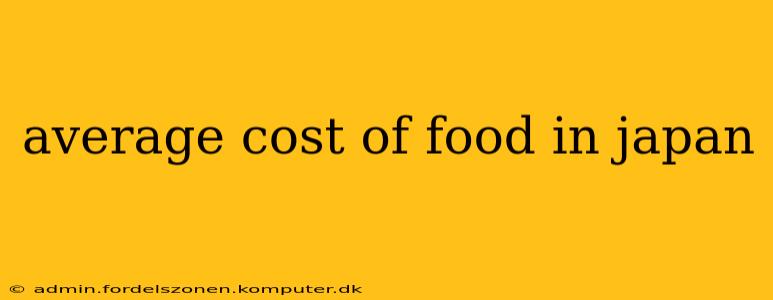Japan, a land of culinary delights, offers a diverse range of dining experiences, from Michelin-starred restaurants to humble ramen shops. Understanding the average cost of food in Japan is crucial for planning your trip, whether you're a budget traveler or a luxury seeker. This guide breaks down the expenses, offering insights into various dining options and helping you budget effectively for your Japanese culinary adventure.
What is the average daily food budget in Japan?
This is a question with a wide range of answers, depending on your eating habits and preferred dining style. A budget traveler might spend as little as ¥3,000-¥5,000 (approximately $20-$35 USD) per day, primarily eating at affordable eateries like convenience stores (konbini) and local restaurants. Mid-range spending could fall between ¥5,000-¥10,000 ($35-$70 USD) per day, allowing for more diverse meals and occasional restaurant outings. Luxury travelers, indulging in high-end dining experiences, could easily spend ¥15,000 or more per day.
How much does it cost to eat at a restaurant in Japan?
Restaurant prices vary drastically depending on the type of establishment and location.
Budget-Friendly Options:
- Convenience Stores (Konbini): Onigiri (rice balls), bento boxes, and sandwiches are readily available and cost around ¥200-¥500 per item. A full meal from a konbini can easily be had for under ¥1000.
- Ramen Shops: A bowl of ramen typically costs ¥700-¥1200, offering a cheap and satisfying meal.
- Fast Food Chains: Similar to Western fast-food chains, these offer affordable options for a quick bite. Expect to pay around ¥500-¥1000 per meal.
- Local Izakayas (Pubs): While some Izakayas can be pricey, many offer affordable small plates (tapas-style) starting from around ¥300-¥800 per item.
Mid-Range Options:
- Family Restaurants: These offer a wider variety of dishes at moderate prices, with meals averaging ¥1000-¥2000.
- Casual Restaurants: Expect to pay ¥1500-¥3000 per person for a sit-down meal in a casual setting.
High-End Options:
- Fine Dining Restaurants: Prices here can vary wildly, but expect to pay several thousand yen per person, or even tens of thousands for a truly luxurious experience. Michelin-starred restaurants are at the top of this range.
What are the typical costs of groceries in Japan?
Grocery shopping in Japan is generally more expensive than in many other countries. However, you can save money by utilizing supermarkets and avoiding convenience stores for larger purchases.
- Supermarkets: Expect to pay comparable prices to those in Western countries for staples like rice, vegetables, and meat.
- Convenience Stores: While convenient, konbini groceries are significantly more expensive than supermarket options.
What factors affect the cost of food in Japan?
Several factors influence the final cost:
- Location: Tokyo and other major cities are generally more expensive than rural areas.
- Seasonality: Prices fluctuate with the seasons, with certain ingredients becoming more expensive during peak seasons.
- Restaurant Type: As mentioned earlier, the type of restaurant dramatically affects prices.
- Dining Style: Ordering à la carte versus a set menu can significantly impact the cost.
How can I save money on food in Japan?
- Eat at local restaurants: Avoid tourist traps and seek out smaller, family-run establishments.
- Utilize convenience stores strategically: Konbini are great for quick snacks and drinks, but not ideal for large meals.
- Cook some meals: If staying in an accommodation with kitchen facilities, cooking some of your meals can significantly reduce costs.
- Take advantage of happy hour deals: Many restaurants offer discounts during happy hour.
- Explore food markets: Food halls and markets often offer cheaper and more authentic food options.
By understanding these factors and incorporating some money-saving tips, you can enjoy the diverse culinary landscape of Japan without breaking the bank. Remember, the average cost is just a guideline; your personal spending will depend on your individual preferences and travel style.
